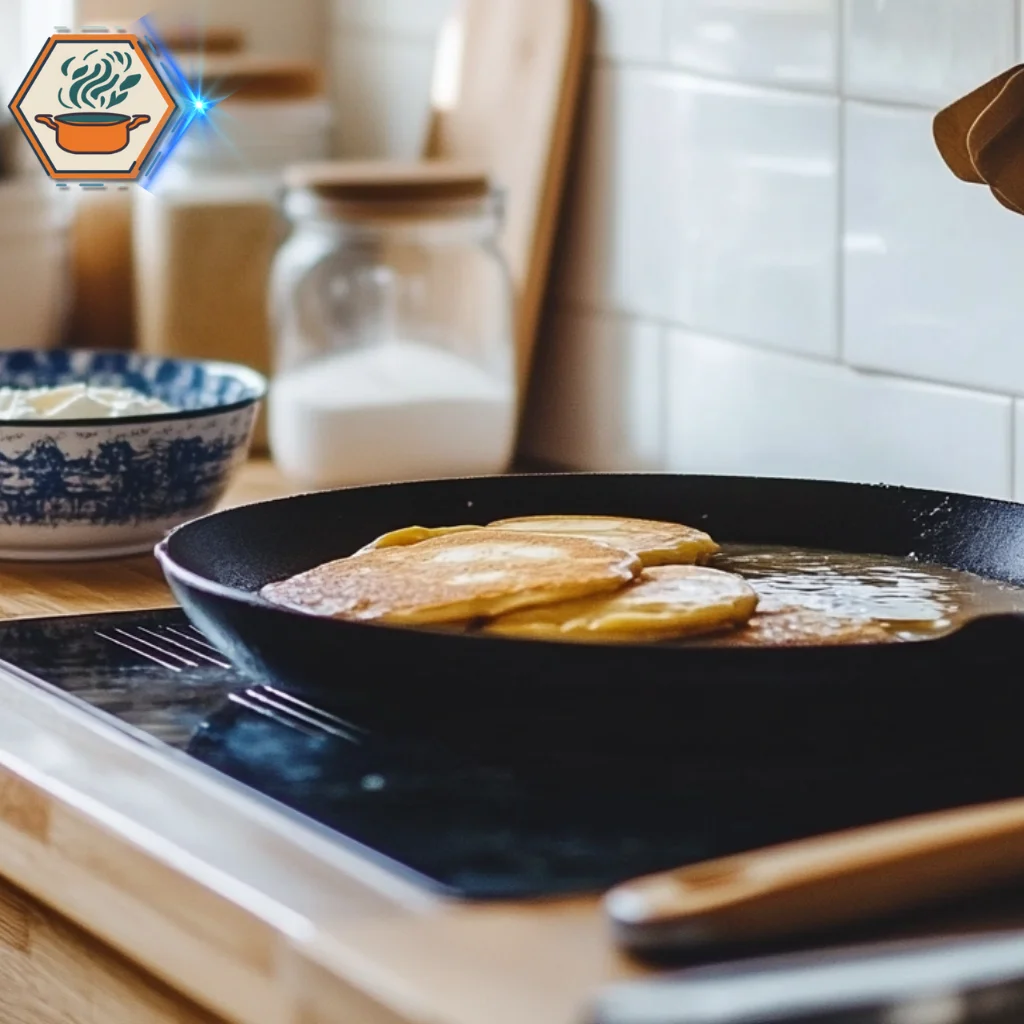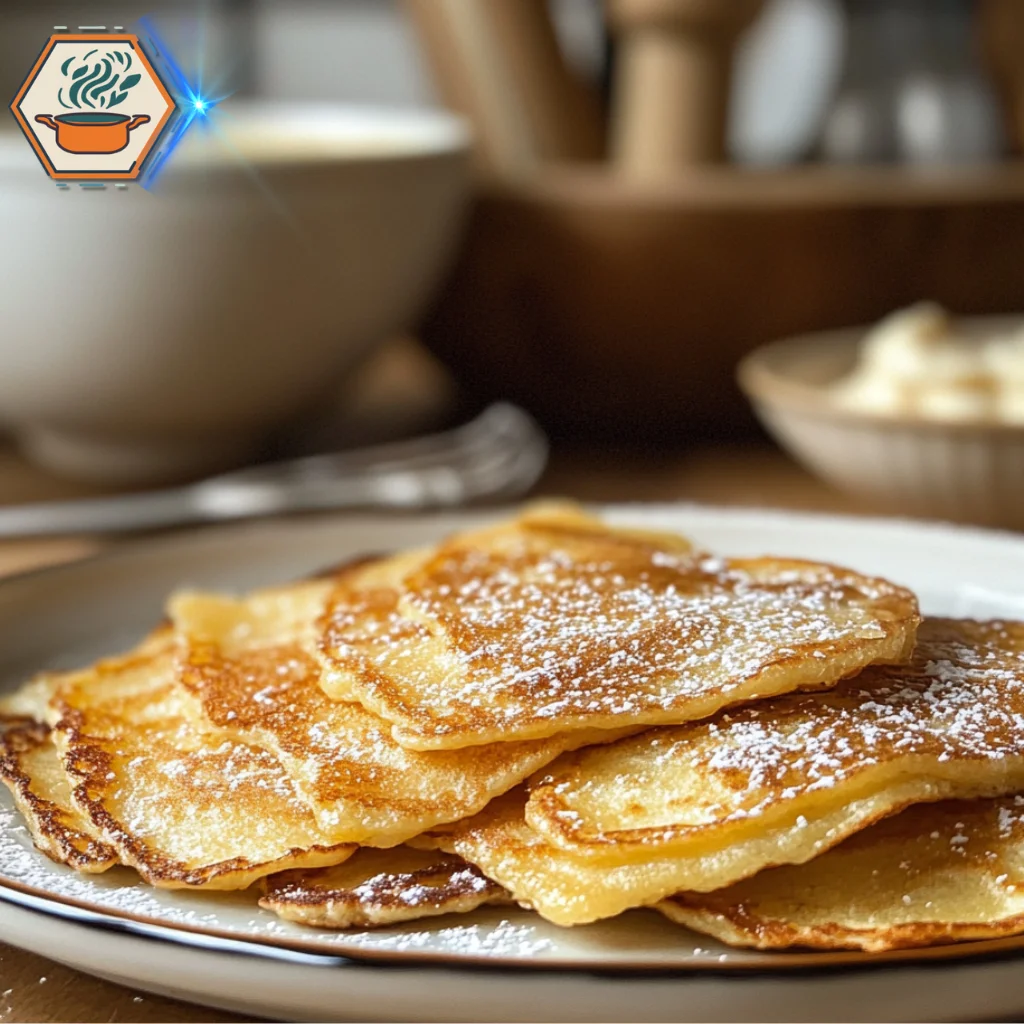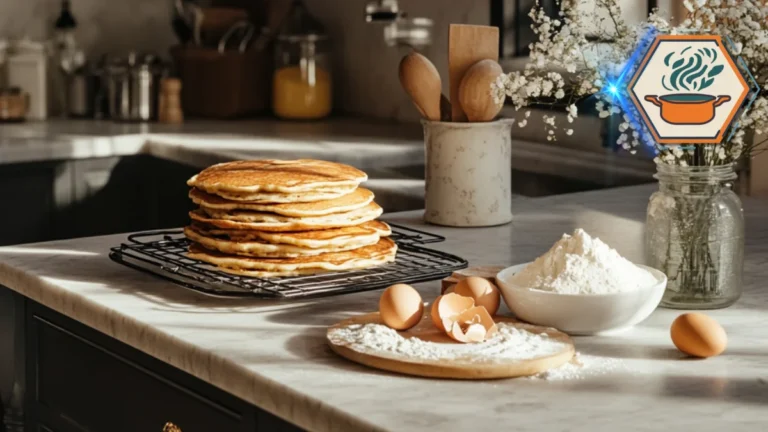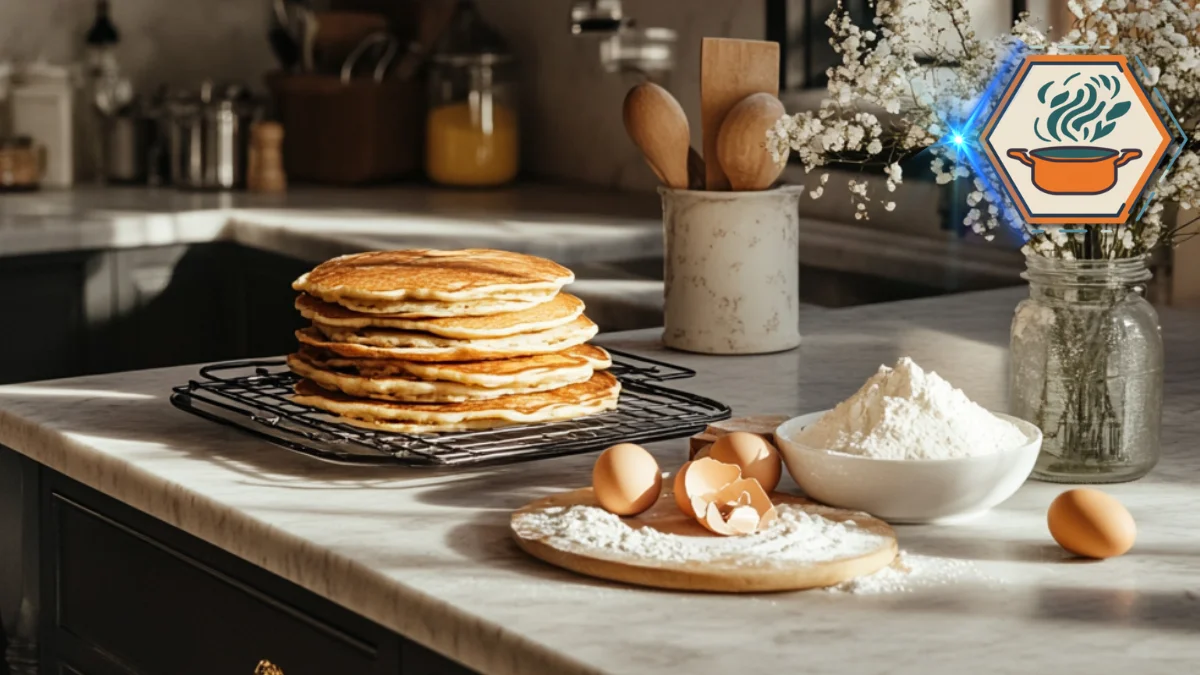Time to read:13 minutes
Table of Contents
Understanding the Basics of Crispy Pancakes
When it comes to crafting the perfect crispy pancake recipe, achieving the ideal balance of texture and flavor is an art and science combined. This section will delve into what makes a pancake crispy, the essential ingredients needed, and the equipment that can make all the difference in crafting that golden, crunchy texture.
What Makes a Pancake Crispy?
The Science Behind Crispy Pancakes
Crispiness in pancakes is all about moisture control and heat. When the batter hits a hot surface, the outer layer quickly dries and forms a crust while the interior cooks gently. This process is enhanced by the right balance of fats and sugars, which caramelize and provide a crunch. Too much moisture, however, can result in a soggy pancake, which is why understanding the right techniques is essential.
Key Differences Between Soft and Crispy Textures
Soft pancakes are fluffy, moist, and tender, often made by adding more liquid and cooking at a moderate temperature. In contrast, crispy pancakes have a slightly firmer exterior, achieved by cooking at a higher temperature and using minimal batter for thin layers. To create that iconic crunch, you’ll need a carefully calibrated mix of ingredients, proper cooking techniques, and the right tools.
Essential Ingredients for Crispy Pancakes
| Ingredient | Quantity (for 4 servings) | Purpose |
|---|---|---|
| All-Purpose Flour | 1 cup | Provides structure and crispiness |
| Milk | 3/4 cup | Adds moisture and helps with texture |
| Egg | 1 large | Binds ingredients and adds richness |
| Butter (melted) | 2 tbsp | Adds flavor and assists in crispiness |
| Oil | 1 tbsp | Enhances crisp edges during cooking |
| Sugar | 2 tsp | Caramelizes to provide a light crunch |
Role of Ingredients Like Flour, Eggs, and Milk
- Flour: Choose a high-protein flour like all-purpose flour to develop more gluten, which adds structure to your pancake and contributes to the crispiness. Avoid cake flour, as it produces a softer texture.
- Eggs: Eggs play a dual role, adding richness and helping bind the ingredients. For crispy pancakes, reduce the number of eggs slightly to avoid an overly soft texture.
- Milk: Use whole milk for its balanced fat content, or substitute a portion with water for a thinner, crispier batter. Be cautious of adding too much liquid, as this can make the batter too runny.
Importance of Using Butter and Oil

- Butter: Provides a rich flavor but can burn at high temperatures. For the best results, mix butter with oil.
- Oil: Neutral oils like vegetable or canola oil are ideal for achieving a crispy finish. They tolerate high heat and help create a consistent crust.
For an optimal crispy effect, brush a small amount of oil evenly over the pan before pouring the batter.
Choosing the Right Equipment
| Equipment | Advantages | Disadvantages |
|---|
| Cast Iron Pan | Retains heat for crisp edges; natural non-stick surface | Heavy and requires seasoning |
| Non-stick Pan | Easy to use and clean; prevents sticking | May not retain heat as well |
| Electric Griddle | Provides consistent heat across the surface | Requires extra counter space |
| Stainless Steel Pan | Versatile and durable | May cause sticking if not preheated |
The Best Frying Pans and Griddles for Achieving Crispiness
Not all cookware is created equal when it comes to making crispy pancakes. The material and quality of your pan or griddle can significantly affect the outcome:
- Non-stick Pans: Ideal for beginners, as they prevent sticking and ensure an even cook. However, they might not hold heat as effectively as other materials.
- Cast Iron Pans: These are a favorite for achieving crispy pancakes due to their excellent heat retention and distribution. Once seasoned, they also provide a naturally non-stick surface.
Advantages of Non-stick Surfaces and Cast Iron
- Non-stick Surfaces: Reduce the need for excessive oil, making them perfect for health-conscious pancake lovers. They’re also easy to clean and maintain.
- Cast Iron Pans: For those looking for authentic crispiness, cast iron is unbeatable. Its ability to hold high heat ensures the edges of your pancakes become irresistibly crunchy.
For more tips check out our detailed guide on How to crisp up pancakes?
Pro Tip: When using cast iron, ensure the pan is well-heated before adding the batter. A cold pan can cause sticking and uneven cooking.
Techniques to Achieve Perfect Crispy Pancakes
Creating the perfect crispy pancake is a delightful combination of science, technique, and attention to detail. Whether you’re a novice or a seasoned cook, mastering the techniques below will elevate your pancakes to golden, crispy perfection.
The Perfect Batter Consistency
Mixing Tips to Avoid Overworking the Batter
A common mistake when making pancake batter is overmixing. Overworking the batter activates too much gluten in the flour, leading to chewy pancakes instead of the desired crispy texture. Here are a few tips:
- Use a gentle folding motion rather than vigorous stirring to preserve texture.
- Combine wet and dry ingredients in separate bowls before mixing them together.
- Leave small lumps in the batter—these will work themselves out during cooking.
Letting the batter rest for 10–15 minutes also allows the flour to hydrate fully, ensuring an even consistency.
Ideal Thickness for Crispy Pancakes
The thickness of your batter directly impacts how crispy your pancakes will be. A thinner batter spreads easily on the pan, creating a thinner pancake with more surface area to crisp up. If your batter is too thick:
- Add a tablespoon of water or milk at a time until it reaches a pourable but not runny consistency.
- Avoid adding excessive liquid, which can make pancakes soggy.
Cooking Temperature and Timing

How to Preheat the Pan to the Right Temperature
Preheating is crucial for crispy pancakes. A cold pan leads to uneven cooking and soggy centers. Follow these steps for perfect results:
- Place your pan on medium heat for 3–5 minutes.
- Test the temperature by sprinkling a few drops of water on the pan. When they sizzle and evaporate rapidly, the pan is ready for use.
- Avoid overheating, as this can burn the pancakes before they cook through.
Timing Tips to Ensure Crisp Edges
Timing is everything when it comes to achieving crispy edges:
- Pour a small amount of batter into the preheated pan and swirl it gently to spread it thinly.
- Cook one side until bubbles appear and the edges firm up, typically 2–3 minutes.
- Turn the pancake gently and cook for another 1–2 minutes.
For more insights on cooking techniques, visit our article on What is the best way to caramelize sugar?
Using Oil and Butter Effectively
When and How to Use Butter vs. Oil for Cooking
The choice between butter and oil is more than just personal preference—it significantly affects the crispiness of your pancakes.
- Butter: Adds a rich flavor but has a low smoke point, meaning it can burn quickly. Use butter for flavor but combine it with oil for better heat tolerance.
- Oil: Neutral oils like vegetable or canola are ideal for maintaining a high temperature, essential for crispy pancakes.
Combining Butter and Oil for the Best Results
To achieve the best of both worlds:
- Add a small amount of oil to the pan and heat it until shimmering.
- Add a pat of butter, letting it melt and combine with the oil.
This method ensures crispy pancakes with a buttery taste while preventing burning.
Flipping the Pancakes Like a Pro
How to Flip Without Losing Crispiness
Flipping pancakes can make or break your efforts for crispiness. Here’s how to do it right:
- Allow the edges to set and bubbles to appear in the center before flipping.
- Use a wide spatula and flip in one swift motion to avoid breaking the pancake.
Avoiding Overcooking After the Flip
The second side cooks faster than the first, so keep a close eye to avoid overcooking. Ideally, it should take 1–2 minutes for the underside to develop a light golden color. Overcooking can lead to dry and overly firm pancakes, which detract from the crispy exterior.
For an in-depth guide on flipping techniques, check out Wikipedia’s article on pancake flipping.
Pro Tips for Crispy Pancakes
- Always clean the pan between batches to remove any residual butter or batter that could burn.
- Serve the pancakes immediately, or place them on a wire rack to prevent steam from softening the crispy edges.
Maintaining and Enhancing Pancake Crispiness

Achieving crispy pancakes is only part of the battle—keeping them crispy after cooking and serving them without compromising their crunch is where the real challenge lies. In this section, we’ll explore essential tips and techniques to preserve and even enhance your pancake crispiness, from cooling and serving strategies to reheating methods that maintain their perfect texture.
Keeping Pancakes Crispy After Cooking
Using Cooling Racks Instead of Stacking
One of the most common mistakes people make is stacking pancakes as they come off the griddle. While this might seem convenient, it traps steam between the pancakes, softening their crispy edges. Instead, follow these steps:
- Place a cooling rack over a baking sheet to catch any drips.
- Place the pancakes in a single layer on the rack, allowing airflow around each for even cooling.
- Keep them in a warm oven (200°F/93°C) to maintain their temperature without sacrificing texture.
Pro Tip: Avoid using paper towels or plates, as they can cause condensation to build up beneath the pancakes, leading to sogginess.
Avoiding Steam to Preserve Crispiness
Steam is the enemy of crispy pancakes. To minimize steam:
- Avoid covering the pancakes with foil or lids.
- If you need to store pancakes temporarily, leave them uncovered or use breathable containers.
For more insights on keeping breakfast dishes fresh and crisp, visit our guide on pancake preservation techniques.
Serving Tips for Maximum Crunch
Best Accompaniments That Don’t Soften Pancakes
Pairing pancakes with the right accompaniments is crucial to maintaining their crisp texture. Heavy syrups and wet toppings can quickly make them soggy. Here are some ideal options:
- Dry Toppings: Sprinkle with powdered sugar, crushed nuts, or shredded coconut.
- Fruits: Use fresh, dry fruits like sliced bananas or berries rather than juicy or canned ones.
- Spreads: Opt for whipped butter or thick spreads like Nutella, applied sparingly to avoid soaking the pancakes.
Plating and Presentation for Crispy Pancakes
How you plate your pancakes can also impact their crispiness:
- Use a flat plate to avoid pooling of liquids around the pancakes.
- Serve syrup on the side in a separate container, allowing diners to control how much they use.
- Stack pancakes with a piece of parchment paper between each one if layering is necessary for presentation.
Pro Tip: To impress your guests, garnish with a light dusting of cinnamon or powdered sugar just before serving.
Reheating Crispy Pancakes the Right Way
Reheating pancakes can be tricky, as the wrong method often results in soft or chewy textures. To maintain their crispiness, choose the right reheating method for your needs.
Oven, Toaster, and Air Fryer Methods
- Oven: Preheat your oven to 350°F (175°C). Place pancakes in a single layer on a baking sheet lined with a wire rack and heat for 5–7 minutes. This method evenly reheats pancakes while keeping their edges crispy.
- Toaster: For a quick option, use a toaster. Simply place the pancake in the toaster on a low setting. This is perfect for thin, crispy pancakes but may not work for thicker ones.
- Air Fryer: Set your air fryer to 325°F (160°C) and place pancakes in a single layer. Heat for 3–4 minutes, checking frequently to prevent over-drying. The air fryer works particularly well for restoring crispiness.
What to Avoid When Reheating
Certain methods can ruin the texture of your pancakes:
- Microwave: While convenient, the microwave produces steam that makes pancakes soft and chewy.
- Stacking During Reheating: This traps moisture, undoing any crispiness you’ve worked to achieve.
Bringing It All Together
By following these techniques, you can maintain and even enhance the crispiness of your pancakes, ensuring they are just as delightful when served as they were fresh off the pan. From proper cooling to thoughtful reheating, small adjustments make a big difference in delivering the perfect crunch every time.
Print
Perfectly Crispy Pancakes: The Ultimate Guide to Golden Perfection
Learn how to make crispy pancakes that are golden, crunchy, and delicious every time. This recipe combines the perfect batter consistency, proper cooking techniques, and the best tips for maintaining that crispy texture from start to finish.
- Total Time: 25 minutes
- Yield: 4 servings
Ingredients
- 1 cup all-purpose flour
- 1 tablespoon sugar
- 1 teaspoon baking powder
- 1/2 teaspoon baking soda
- 1/2 teaspoon salt
- 3/4 cup whole milk (or a mix of milk and water for thinner pancakes)
- 1 egg (slightly beaten)
- 1 tablespoon unsalted butter (melted)
- 1 tablespoon vegetable or canola oil (for cooking)
- Optional: Powdered sugar, crushed nuts, or fresh fruits for topping.
Instructions
Mix the Dry Ingredients:
In a medium bowl, whisk together the flour, sugar, baking powder, baking soda, and salt.Prepare the Wet Ingredients:
In another bowl, combine milk, the beaten egg, and melted butter. Gently mix the wet ingredients into the dry ingredients until just combined (don’t overmix). Small lumps are fine.Preheat the Pan:
Heat a cast iron or non-stick pan over medium heat for 3–5 minutes. Brush with a light coating of oil.Cook the Pancakes:
Pour a small amount of batter (around 1/4 cup) into the pan, spreading it thinly for maximum crispiness. Cook for 2–3 minutes until bubbles appear and the edges firm up. Flip gently and cook for an additional 1–2 minutes until golden.Keep Pancakes Crispy:
Place cooked pancakes on a wire rack in a 200°F (93°C) oven to keep them warm and maintain crispiness while cooking the rest.Serve Immediately:
Serve with your choice of dry toppings like powdered sugar or crushed nuts, and keep syrup on the side to prevent sogginess.
Notes
- For extra crispiness, use a mix of 250mg
- pancakes to avoid steam buildup.
- Prep Time: 10 minutes
- Cook Time: 15 minutes
- Category: Breakfast
- Method: Pan-frying
- Cuisine: American
- Diet: Vegetarian
What makes pancakes crispy?
Crispiness in pancakes is achieved by the right combination of ingredients, batter consistency, and cooking techniques. Using a thin batter, preheating the pan to the correct temperature, and combining butter and oil for frying are key to making perfectly crispy pancakes.
How do I ensure my pancakes stay crispy after cooking?
To keep your crispy pancakes from going soggy, place them on a wire cooling rack instead of stacking them. This allows air to circulate, preventing steam from softening the edges. You can also keep them warm in a 200°F (93°C) oven without covering them.
What type of pan is best for making crispy pancakes?
A cast iron pan is ideal for making crispy pancakes due to its excellent heat retention, which helps create a perfectly golden crust. However, a high-quality non-stick pan can also work well for beginners as it prevents sticking and ensures even cooking.
Can I make crispy pancakes without eggs?
Yes, you can make crispy pancakes without eggs by using substitutes like flaxseed meal, chia seeds, or applesauce. However, eggs provide structure and richness, so you may need to adjust the consistency of your batter to maintain crispiness.
What is the secret to making thin and crispy pancakes?
To achieve thin and crispy pancakes, use a thinner batter by reducing the flour or adding a small amount of extra liquid (milk or water). Spread the batter thinly on the pan and cook at a medium-high temperature to get those golden, crispy edges.
Why do my pancakes turn out soggy instead of crispy?
Soggy pancakes are often caused by batter that’s too thick, an under-heated pan, or excessive liquid in the batter. To fix this, ensure your batter has a pourable but not runny consistency, and preheat your pan properly before cooking.
Can I make crispy pancakes ahead of time?
Yes, you can prepare crispy pancakes ahead of time by cooking them and storing them in a single layer on a wire rack. Reheat them in an oven, toaster, or air fryer to restore their crispiness before serving.
What toppings work best with crispy pancakes?
The best toppings for crispy pancakes are those that don’t make them soggy. Try powdered sugar, crushed nuts, fresh fruits like berries or bananas, or spreads like Nutella. Serve syrups on the side to maintain their crispy texture.
How do I reheat crispy pancakes without losing their texture?
To reheat crispy pancakes, use an oven, toaster, or air fryer. Avoid microwaves as they create steam that can make pancakes soft. Place pancakes in a single layer to ensure even reheating and maintain their crispiness.

